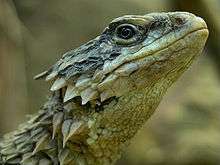Smaug (genus)
| Smaug | |
|---|---|
 | |
| Giant girdled lizard (Smaug giganteus) | |
| Scientific classification | |
| Kingdom: | Animalia |
| Phylum: | Chordata |
| Class: | Reptilia |
| Order: | Squamata |
| Family: | Cordylidae |
| Genus: | Smaug Stanley et al., 2011[1] |
| Diversity | |
| 8 species (see text) | |
The genus Smaug is a group of spiny southern African lizards, separated from the genus Cordylus in 2011 on the basis of a comprehensive molecular phylogeny of the Cordylidae. The type species is the giant girdled lizard, S. giganteus (formerly Cordylus giganteus).[1]
Etymology
The genus was named for the character Smaug, in J. R. R. Tolkien's The Hobbit:[2]
Smaug is the name of the dragon encountered by Bilbo Baggins, the protagonist of J.R.R. Tolkien’s book The Hobbit. According to Tolkien the name is derived from the Old German verb smeugen – to squeeze through a hole. Like the type species, Smaug lived underground and was heavily armored. Appropriately Tolkien was born in the Free State province, South Africa, the core area of distribution of the type species. The name is masculine.[1]
Zonurus, the former genus name, is from Greek zōnē ‘girdle’ + oura ‘tail’. [3]
Description
Smaug are large lizards (extremely large among the Cordylidae), measuring up to 112–205 mm (4.4–8.1 in) in snout–vent length. The body is sub-cylindrical in cross-section and robust. Limbs are moderate in length and digits are unreduced. Dorsal and caudal scales are enlarged and spinose. Occipital spines are greatly enlarged. Nasal scales are not in contact with one another. Frontonasal scale is in broad contact with the rostral scale. Tongue is partly or fully pigmented. Osteoderms are distributed across entire body.[1]
Reproduction
Smaug are viviparous and give birth to 1–6 young.[1]
Species
There are eight species:[4][5]
- Smaug barbertonensis
- Smaug breyeri (Waterberg girdled lizard)
- Smaug depressus (Zoutpansberg girdled lizard)
- Smaug giganteus (giant girdled lizard), the type species
- Smaug mossambicus (Mozambique girdled lizard)
- Smaug regius
- Smaug vandami (Van Dam's girdled lizard)
- Smaug warreni (Warren's girdled lizard)
References
- 1 2 3 4 5 Stanley, Edward L.; Bauer, Aaron M.; Jackman, Todd R.; Branch, William R.; Mouton, P. Le Fras N. (2011). "Between a rock and a hard polytomy: Rapid radiation in the rupicolous girdled lizards (Squamata: Cordylidae)" (PDF). Molecular Phylogenetics and Evolution. 58 (1): 53–70. doi:10.1016/j.ympev.2010.08.024.
- ↑ "Protect and Prosper". American Museum of Natural History. Retrieved August 30, 2015.
- ↑ http://www.oxforddictionaries.com/definition/english/zonure
- ↑ Smaug at the Reptarium.cz Reptile Database
- ↑ Stanley, E. L.; Bates, M. F. (2014). "Here be dragons: A phylogenetic and biogeographical study of the Smaug warreni species complex (Squamata: Cordylidae) in southern Africa". Zoological Journal of the Linnean Society. 172 (4): 892–909. doi:10.1111/zoj.12187.